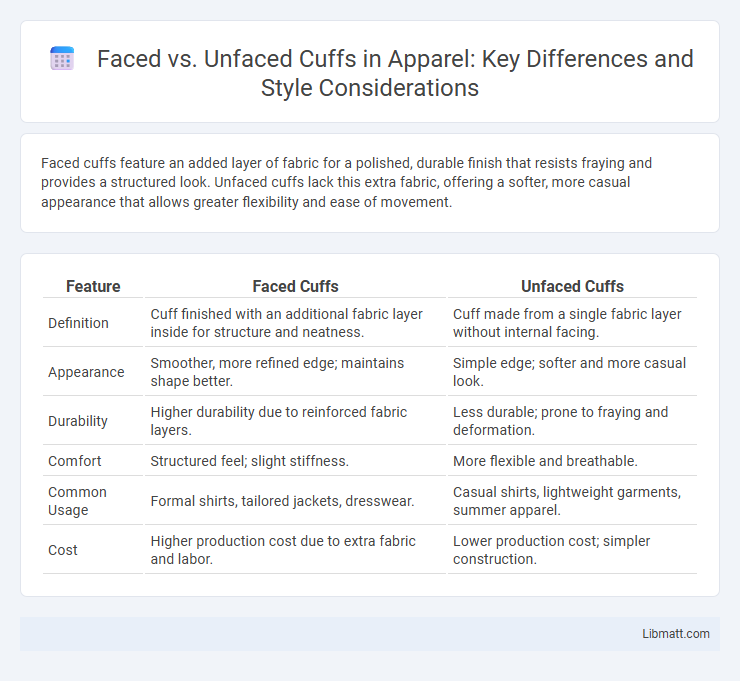Faced cuffs feature an added layer of fabric for a polished, durable finish that resists fraying and provides a structured look. Unfaced cuffs lack this extra fabric, offering a softer, more casual appearance that allows greater flexibility and ease of movement.
Table of Comparison
| Feature | Faced Cuffs | Unfaced Cuffs |
|---|---|---|
| Definition | Cuff finished with an additional fabric layer inside for structure and neatness. | Cuff made from a single fabric layer without internal facing. |
| Appearance | Smoother, more refined edge; maintains shape better. | Simple edge; softer and more casual look. |
| Durability | Higher durability due to reinforced fabric layers. | Less durable; prone to fraying and deformation. |
| Comfort | Structured feel; slight stiffness. | More flexible and breathable. |
| Common Usage | Formal shirts, tailored jackets, dresswear. | Casual shirts, lightweight garments, summer apparel. |
| Cost | Higher production cost due to extra fabric and labor. | Lower production cost; simpler construction. |
Introduction to Cuffed Garments
Cuffed garments feature either faced or unfaced cuffs, which influence both style and comfort. Faced cuffs include an extra fabric layer for reinforcement and a polished look, ideal for formal wear, while unfaced cuffs offer a lighter, more casual feel with less structure. Your choice depends on the garment's intended use, balancing durability and aesthetic preferences.
What Are Faced Cuffs?
Faced cuffs feature an extra layer of fabric sewn onto the cuff's exterior, providing a polished and structured appearance often found in formal wear and tailored garments. This additional facing reinforces the cuff area, enhancing durability while maintaining a clean aesthetic that complements your outfit. Understanding the distinction between faced and unfaced cuffs helps you choose the right style for both functional and stylistic purposes.
What Are Unfaced Cuffs?
Unfaced cuffs refer to the type of cuff construction in garment making where the fabric's raw edges are left exposed or minimally finished without an additional facing layer. They typically utilize a single layer of fabric folded over, creating a simpler, more casual appearance compared to faced cuffs that have an extra fabric layer sewn inside for a polished look. This design choice impacts both the cuff's durability and aesthetic, often preferred in relaxed styles and lightweight materials.
Construction Methods of Faced Cuffs
Faced cuffs are constructed by sewing a separate piece of fabric, called the facing, to the edge of the cuff to provide a clean, structured finish and prevent fraying. This method involves turning the facing to the inside of the cuff and securing it with stitching lines, offering a polished look and added durability. Your garment benefits from a refined aesthetic and enhanced longevity through this meticulous construction technique.
Construction Methods of Unfaced Cuffs
Unfaced cuffs are constructed by folding back the fabric without adding an extra lining or facing, relying on the fabric's natural weight and structure for shape and durability. This method simplifies production and reduces bulk, often favored in casual or lightweight garment designs. The edges are typically finished with clean stitching or serging to prevent fraying, maintaining a sleek, minimalistic appearance.
Aesthetic Differences: Faced vs Unfaced Cuffs
Faced cuffs feature an additional layer of fabric that creates a clean, structured edge and a polished appearance, while unfaced cuffs display a raw or minimally finished edge that offers a more casual, natural look. The faced design enhances cuff durability and sharpness, making it ideal for formal wear, whereas unfaced cuffs provide subtle texture and softness suitable for relaxed or artistic styles. Your choice between faced and unfaced cuffs directly impacts the garment's visual impact, balancing refinement against effortless charm.
Durability and Functionality Comparison
Faced cuffs feature an additional fabric layer, significantly enhancing durability by providing extra protection against wear and tear compared to unfaced cuffs. This structural reinforcement also maintains cuff shape and functionality during prolonged use, reducing fraying and deformation. Unfaced cuffs offer a lightweight option but may require more frequent repairs or replacements due to less resistance to abrasion and stretching.
Best Uses for Faced Cuffs
Faced cuffs, featuring a visible finished edge, are best used in tailored garments where a polished, professional appearance is important, such as dress shirts, blouses, and formal jackets. They provide a clean, crisp look that enhances the garment's overall aesthetic, making them ideal for business attire and occasions requiring attention to detail. Their structured finish also adds durability to the cuff area, prolonging the lifespan of frequently worn clothing.
Best Uses for Unfaced Cuffs
Unfaced cuffs are ideal for casual or lightweight garments such as t-shirts, sweatshirts, and activewear, offering flexibility and breathability without added bulk. They provide a clean, seamless look while maintaining comfort, making them perfect for layered outfits and relaxed styles. This type of cuff enhances movement and is especially suitable for fabrics like jersey and fleece where softness and stretch are key.
Choosing Between Faced and Unfaced Cuffs
Choosing between faced and unfaced cuffs depends on the garment's style and durability requirements. Faced cuffs offer a clean, structured finish suitable for tailored shirts and jackets, enhancing longevity and resistance to wear. Unfaced cuffs provide a casual look with lighter construction, ideal for relaxed styles where comfort and breathability are prioritized.
faced vs unfaced cuffs Infographic

 libmatt.com
libmatt.com